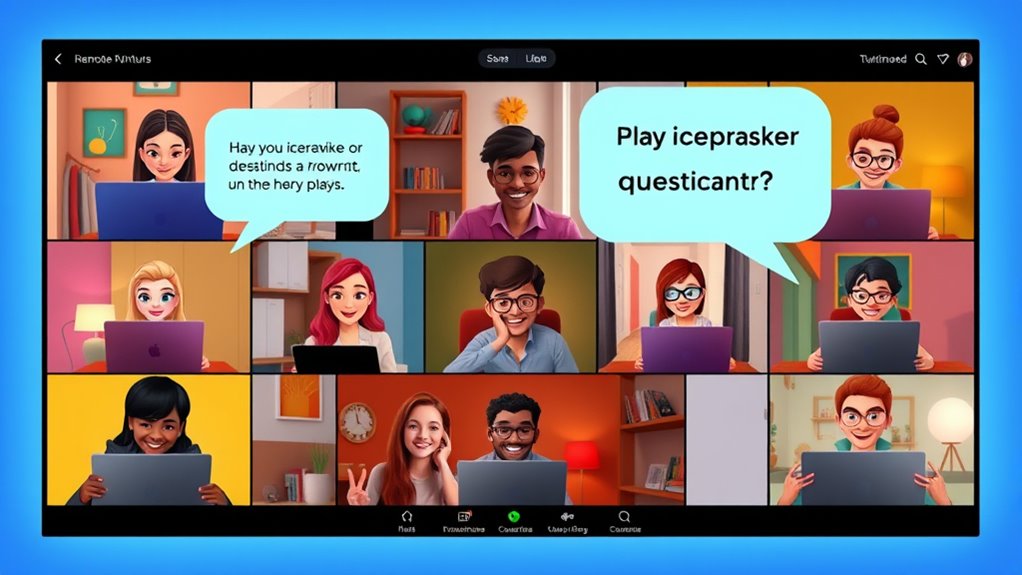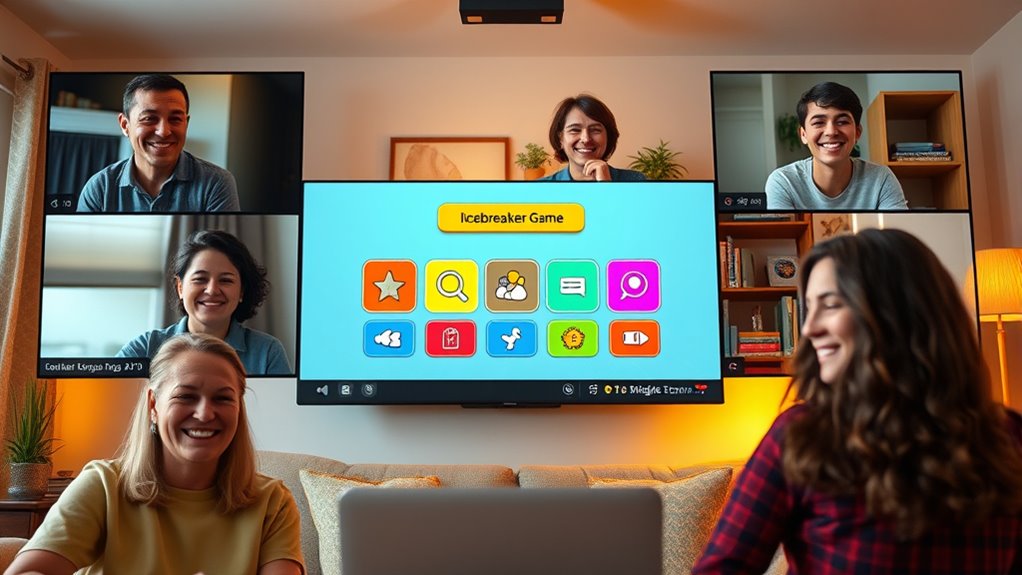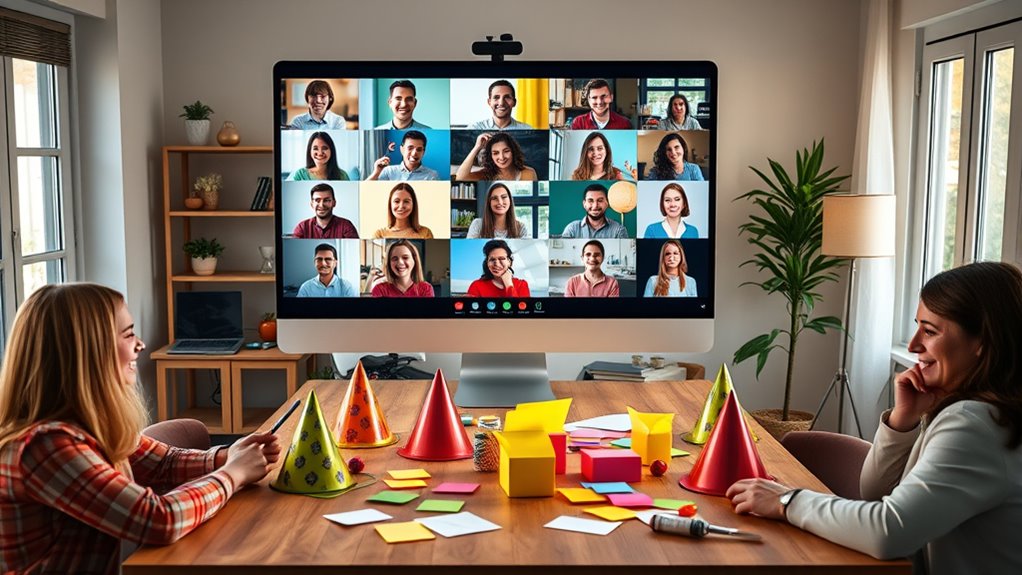To energize your remote meetings, try quick, fun icebreakers like asking playful questions or sharing personal items in Show and Tell. Incorporate game-based activities like Two Truths and a Lie, Pictionary, or Speed Networking to foster interaction and build connections. Using digital tools and creative prompts keeps everyone engaged and encourages open communication. Keep exploring different warm-up ideas to discover more effective ways to make every virtual gathering lively and engaging.
Key Takeaways
- Use quick, light-hearted questions to encourage relaxed conversations and build rapport among remote participants.
- Incorporate interactive games like virtual Pictionary or emoji storytelling to boost engagement and creativity.
- Leverage visual tools and digital prompts to facilitate collaboration and make activities more dynamic.
- Facilitate structured activities like speed networking or show and tell to promote authentic connections.
- Combine active listening, empathy, and shared visual tasks to create a fun, inclusive, and productive virtual environment.
Fun and Quick Icebreaker Questions to Start Conversations

Looking for a simple way to break the ice? Fun and quick icebreaker questions are your best bet. They serve as effective conversation starters that get everyone talking without feeling forced. Use light-hearted icebreaker questions like, “What’s your go-to comfort food?” or “If you could travel anywhere right now, where would you go?” These questions encourage genuine responses and help people relax. They’re perfect for kicking off meetings or virtual hangouts, making the environment more inviting. Keep your questions brief and fun to maintain energy. The goal is to spark curiosity and laughter, helping everyone feel more connected. By choosing the right conversation starters, you’ll set a positive tone and make your online interactions more engaging right from the start. Additionally, understanding the importance of color accuracy can help in creating a more vibrant and engaging environment during virtual activities.
Virtual Two Truths and a Lie: a Classic Game With a Digital Twist

To make Virtual Two Truths and a Lie work smoothly, you need solid digital adaptation tips. Engaging participants effectively keeps everyone involved and energized. With the right approach, this game can be a fun and memorable way to break the ice online. Incorporating interactive elements can boost participation and make the experience more dynamic for everyone.
Subheading 1: Digital Adaptation Tips
Have you ever wondered how classic icebreaker games translate to the digital world? To adapt Virtual Two Truths and a Lie effectively, focus on clear instructions and visual cues to guide participants. Use video conferencing tools with chat features to encourage everyone to share their statements and guesses, boosting remote engagement techniques. Keep the game brief to maintain energy and avoid fatigue. Incorporate virtual ice strategies like polling or reactions to make guesses interactive. Guarantee everyone’s microphone and camera work smoothly, so no one feels left out. Encourage participants to be creative and authentic in their statements, which sparks conversations. By applying these digital adaptation tips, you create an engaging environment that fosters connection and keeps remote teams motivated. Additionally, understanding audience engagement principles can help tailor activities that sustain interest throughout the session.
Subheading 2: Engaging Participants Effectively
Engaging participants effectively during Virtual Two Truths and a Lie requires intentional strategies to keep everyone involved and energized. Using icebreaker frameworks helps structure the game to maximize participant engagement and ensure inclusivity. Encourage everyone to prepare interesting truths and a believable lie, which sparks curiosity and conversation. During the game, actively facilitate by calling on different participants to share and guess, maintaining a lively pace. Incorporate visual cues or chat features to enhance interaction, especially for remote attendees. Keep the atmosphere light and fun, emphasizing the importance of participation over accuracy. Additionally, leveraging AI tools can assist in generating engaging prompts or moderating the game to keep energy levels high. By thoughtfully applying icebreaker frameworks, you create an environment where remote team members feel connected and motivated to engage. This approach transforms a simple game into a powerful team-building tool.
Show and Tell: Sharing Personal Items to Build Connections

Ever wonder how sharing a personal item can help you connect with others online? Show and Tell encourages personal storytelling, giving participants a chance to share meaningful objects that reveal their interests or backgrounds. This activity fosters authenticity and creates a sense of vulnerability, making conversations more genuine. By sharing items that reflect cultural sharing, you invite others to learn about different traditions or experiences, enriching the group’s understanding. It’s an engaging way to break down barriers and build trust, especially in remote settings. As each person introduces their item, they not only tell a story but also create a space for empathy and connection. Incorporating eye patches as part of self-care routines can also serve as a relatable topic that sparks conversations about wellness and daily habits. This simple yet powerful exercise turns a virtual meeting into a moment of shared humanity.
The Emoji Story Challenge to Spark Creativity and Laughter

The Emoji Story Challenge is a fun and creative activity that encourages participants to craft stories using only emojis. You’ll assign each person a set of emojis, and they must create a short story that connects them. This exercise sparks emoji storytelling, allowing everyone to showcase their imagination in a playful way. As participants share their stories, laughter induction naturally occurs, especially when interpretations are unexpected or humorous. The challenge breaks the ice by fostering a relaxed environment where creativity thrives, and everyone feels comfortable contributing. It’s simple to organize and highly engaging, making it perfect for remote teams seeking a lively, interactive warm-up. Plus, it guarantees smiles and a sense of shared fun, setting a positive tone for the rest of your meeting. Incorporating empathetic communication strategies can further enhance participant engagement and create a more inclusive atmosphere.
Speed Networking: Rapid-Fire Introductions to Break the Ice

Building on the playful energy of emoji storytelling, speed networking offers a dynamic way to break the ice quickly. This activity resembles virtual speed dating, where participants engage in rapid introduction techniques to connect in a short time. You set up breakout rooms or timed chats, giving each person a fixed window—usually 2-3 minutes—to introduce themselves and share something interesting. The fast pace keeps energy high and prevents awkward silences. As participants rotate through quick conversations, they discover common interests and build rapport efficiently. Speed networking is perfect for remote teams, fostering connections without long, drawn-out discussions. It’s an engaging way to warm up interactions and set a lively tone for the rest of your virtual gathering. To optimize the experience, understanding cookie categories can help you tailor online activities to enhance user engagement and ensure smooth participation.
Virtual Pictionary: Engaging Teams With Collaborative Drawing

Virtual Pictionary sparks creative drawing challenges that get everyone involved. It encourages team members to communicate visually and share ideas quickly. This activity makes collaboration fun and helps break down communication barriers online. Incorporating a cozy bedroom setting can also create a more relaxed atmosphere during virtual team-building sessions.
Creative Drawing Challenges
Creative drawing challenges like Pictionary transform simple team activities into engaging and interactive experiences. You can spice things up by integrating digital sketching tools that allow remote participants to draw in real-time. Use artistic prompts to inspire creativity and add variety, making each round fresh and exciting. These challenges encourage team members to think quickly and communicate visually, fostering collaboration and fun. By sharing screens or using collaborative drawing apps, everyone stays involved, regardless of location. The focus on digital sketching makes the activity accessible and dynamic, breaking down barriers of distance. Incorporating active listening and empathy into these exercises can further enhance understanding among team members, making the activity even more meaningful. With creative prompts, you’ll keep energy high and participation active, making these challenges memorable and effective icebreakers for remote teams.
Promoting Team Communication
Engaging team members in collaborative drawing activities like Pictionary encourages open communication and quick thinking. This game fosters office camaraderie by breaking down barriers and encouraging everyone to share ideas visually. When team members draw and guess in real-time, it promotes transparency and active listening, essential for strong remote rapport. Participants learn to interpret clues quickly and clarify their thoughts through visual cues, enhancing overall communication skills. As everyone collaborates on a shared goal, trust builds naturally, making future interactions smoother. Virtual Pictionary creates a relaxed environment where team members feel comfortable expressing themselves, which translates into better cooperation and teamwork outside the game. Incorporating mindful decluttering strategies during these activities can also help teams maintain focus and organization, improving overall productivity. Ultimately, it strengthens the foundation for ongoing open dialogue, even in a remote setting.
Frequently Asked Questions
How Do I Ensure Remote Participants Stay Engaged During Icebreaker Games?
To guarantee remote participants stay engaged during icebreaker games, focus on virtual engagement and participation strategies. Keep activities short, interactive, and inclusive, encouraging everyone to share. Use visuals and chat features to foster involvement, and call on participants by name to boost engagement. Incorporate fun, light-hearted questions that resonate with the group. By actively involving everyone and maintaining a lively pace, you create a welcoming environment that keeps remote attendees engaged throughout.
What Are Some Tips for Customizing Icebreakers for Diverse Teams?
When customizing icebreakers for diverse teams, you should focus on activity personalization and cultural sensitivity. Ask team members about their interests and backgrounds to create inclusive activities that resonate with everyone. Avoid stereotypes and choose neutral, adaptable games. By respecting different cultures and preferences, you foster a more welcoming environment that encourages genuine participation and helps build stronger team connections.
How Can I Handle Shy or Introverted Participants in Virtual Icebreakers?
Ever feel like silent participation is a wall you can’t break? To handle shy or introverted participants, use inclusive techniques that gently draw them out without pressure. Create small, safe spaces for sharing, like chat boxes or one-on-one chats, where they feel comfortable. Respect their pace, and avoid forcing participation. These strategies help shy team members engage more actively, making everyone feel valued and included in your virtual space.
Are There Any Tools or Apps That Facilitate These Online Icebreaker Games?
You can find several virtual collaboration tools and gamified apps that make online icebreaker games engaging and easy to run. Platforms like Miro, Mentimeter, and Kahoot! offer interactive features perfect for remote teams. These tools foster participation, even for shy or introverted members, by providing fun, structured activities. Using such apps guarantees your icebreakers are lively, inclusive, and effective at building team rapport in virtual settings.
How Do I Measure the Success of Virtual Icebreaker Activities?
Picture your virtual meeting as a lively gathering—how do you know if everyone’s truly engaged? You measure success through feedback collection, watching for smiles, nods, and active participation. Participant satisfaction is your compass, guiding you to effective icebreakers. After the activity, ask for quick surveys or open comments. These insights reveal whether your warm-up fostered connection or needs tweaking, helping you craft even better virtual interactions.
Conclusion
By blending bold, playful, and purposeful activities, you can break barriers and build bonds effortlessly. These engaging, energetic icebreakers ignite interest, inspire interaction, and ignite instant inclusivity. Whether you’re tossing out quick questions or tackling creative challenges, you’ll transform tedious virtual meetings into lively, lasting connections. Embrace these easy, effective exercises to elevate your online experiences, ensuring everyone feels involved, inspired, and enthusiastic to engage.









